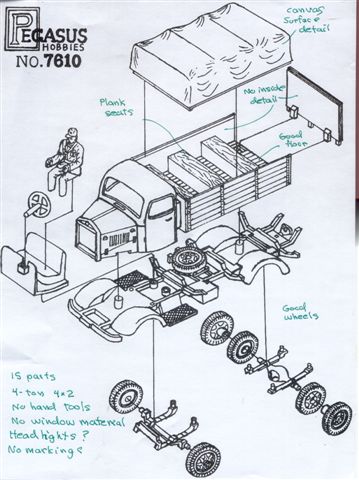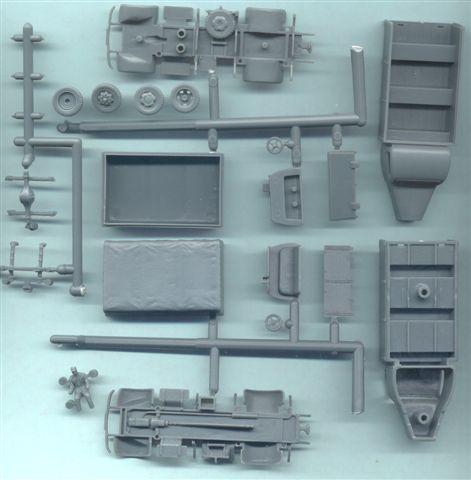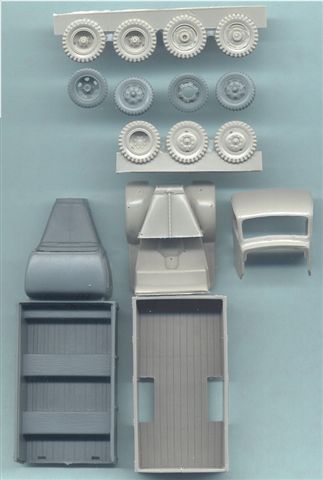Looking at the
box art from Pegasus Hobbies we have a photo of two assembled and
painted truck models included within the box with a figure for scale.
One truck is painted in a pre-1943 dark gray and the right one in
a post-1943 three-color camouflage.
This model is a bit of a conundrum for me. The model most resembles
a Mercedes 3-ton capacity truck, comparable to the more well-known
Opel Blitz. While certain features such as the bed and overall cab
shape resemble that of the Mercedes L3000, it has enough vague features
that it could be modified to resemble other German 3-ton trucks such
as a Magirus S3000 or a Borgward B3000. The front grill is missing
the large Mercedes Benz emblem common to many but not all Mercedes
L3000 trucks.
1. This kit contains two small-scale German military trucks of the
World War 2 period. Each truck consists of 15 injection-molded gray
colored styrene parts on two small sprues, including a ¾ driver
figure. The infantry figure on the box art is not included.
2. No decals markings are included such as license plates.
3. No clear window material is included. The kit is also missing headlights,
Notek light, width indicators for the front fenders, handtools, tow
hooks and windshield wipers. All these items can be scratchbuilt,
borrowed or stolen.

4. Here are the basic hand-drawn instructions for the assembly. Notice
that the parts are not numbered. It’s pretty simple and dry-fitting
parts indicated to me that it should go together well. The upper cab
and bed part and the driver’s seat snap in pretty securely to
the chassis. Parts like the steering wheel, the suspension and the
wheels appear to need gluing.
5. Looking at the front suspension we see that the truck has only
rear-wheel drive, a 4x2 (no differential on the front axle), hence
it is called a L3000 S. (The four wheel drive version is the Mercedes
L3000 A, a 4x4.)

6. The scan of the parts shows the two model kits included within
the box. Molding looks crisp with good definition and no sink holes
or flash evident. This kit is quite simplified compared to the old
ESCI and the Academy Opel
Blitz kits.
7. The bench seats in the truck bed are molded in as boxes rather
than the removable boards in the real truck. If we wish a good display
model this is unacceptable so we’ll have to model the bed full
of cargo or with the tarp on. The tarp has decent but not greatly
accurate surface detail.
8. The bed interior is missing surface detail.
9. The fenders, transmission, bumper and spare tire are molded into
the chassis, seen here at the very top and very bottom of the photo.
10. The running board below the doors have nice tread pattern but
the steering wheel is a little thick.
11. A hole needs to be drilled below the radiator for the crank starter.
12. The towing pintle needs to be drilled and reamed out to make it
hollow for a trailer hitch.

13. This scan compares the gray plastic Pegasus model at left with
the light gray resin model by WSW Modellbau
of the same L3000 S truck on the right. The WSW model is both narrower
but has a significantly longer bed. I have some different measurements
for this truck from different books; it appears that the bed came
in varying lengths. According to "Mercedes At War" by Schiffer
Publishing and the "kfzderwehrmacht" website, the dimensions
of the real L3000 truck are: 6.25 meters or 6.7 m long, x 2.35 m wide
x 2.6 m high. This means our 1/72 scale model should be: 87-mm or
93-mm long, by 33-mm wide. The Pegasus L3000 truck measured at 86
x 30-mm which means it is pretty close in length for the shorter length
of 87-mm, but appears too narrow. Based on another
reference the Pegasus truck bed of 48 x 30-mm closely matches the
1/72-scale truck bed measurements of 48.6 x 29-mm.
14. A thing that bothers me with both kits is the shape of the engine
hood (bonnet) where it meets the cab. Based on photos of the real
L3000, I believe the engine area should be narrower where it meets
the cab then flare out in a soft curve to the width of the cab. The
engine hoods of these models both expand evenly from the radiator
back to the width of the cab. It is because of this apparent flaw
in the cab and hood that I think both of these models could be converted
to another 3-ton truck such as the Magirus S3000 or Borgward B3000
trucks.
15. In order to mold the cab and bed as one piece Pegasus added a
spacer block to connect the two parts; if you wish a good display
model you’ll have to hide this somehow, such as with a folded
canvas tarp perhaps.
16. The darker gray wheels with the Pegasus model are noticeably smaller
in diameter. The WSW wheels more
closely match the size of other 3-ton capacity 4x2 German trucks such
as ESCI’s Opel Blitz kit.
17. The Pegasus wheels have many more holes around the rim. I have
seen both types of rims in photos of Mercedes L3000 trucks
18. The hub detail is more accurate on the WSW
wheels.
19. Overall the Pegasus L3000 model is a nice kit that can build to
an accurate Mercedes truck or can be modified to produce a similar
3-ton capacity truck made by several other German companies of the
period. It can be built with little modification to a fine wargaming
or model for a novice; or it can be detailed into a fine display model.
References
Mercedes At War, German Trucks &
Cars In World War II Vol. IV. Schiffer Publishing, 1991. This is a
good cheap, softcover reference book.
Trucks Of The Wehrmacht, by Reinhard
Frank, Schiffer Publishing, 1994.
http://www.autogallery.org.ru/gothers.htm
: Oldtimers Picture Gallery website from Russia of trucks and autos,
mainly 1932-1945
http://www.o5m6.de/ForeignTrucks.html
: Engines of the Red Army website focusing on Soviet vehicles of WW2
http://www.kfzderwehrmacht.de/index.html
: Good website with information on all types of vehicles from many
nations during the WW2 period.
|

